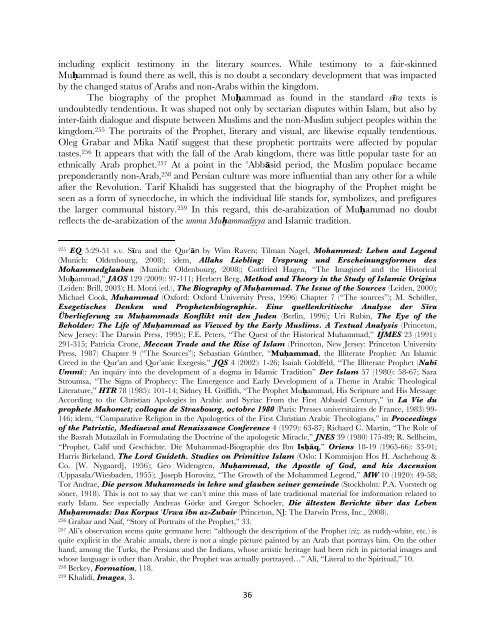Muhammad_Article.349.. - Dr. Wesley Muhammad
Muhammad_Article.349.. - Dr. Wesley Muhammad
Muhammad_Article.349.. - Dr. Wesley Muhammad
You also want an ePaper? Increase the reach of your titles
YUMPU automatically turns print PDFs into web optimized ePapers that Google loves.
including explicit testimony in the literary sources. While testimony to a fair-skinned<br />
MuÈammad is found there as well, this is no doubt a secondary development that was impacted<br />
by the changed status of Arabs and non-Arabs within the kingdom.<br />
The biography of the prophet MuÈammad as found in the standard sÊra texts is<br />
undoubtedly tendentious. It was shaped not only by sectarian disputes within Islam, but also by<br />
inter-faith dialogue and dispute between Muslims and the non-Muslim subject peoples within the<br />
kingdom. 255 The portraits of the Prophet, literary and visual, are likewise equally tendentious.<br />
Oleg Grabar and Mika Natif suggest that these prophetic portraits were affected by popular<br />
tastes. 256 It appears that with the fall of the Arab kingdom, there was little popular taste for an<br />
ethnically Arab prophet. 257 At a point in the #Abb§sid period, the Muslim populace became<br />
preponderantly non-Arab, 258 and Persian culture was more influential than any other for a while<br />
after the Revolution. Tarif Khalidi has suggested that the biography of the Prophet might be<br />
seen as a form of synecdoche, in which the individual life stands for, symbolizes, and prefigures<br />
the larger communal history. 259 In this regard, this de-arabization of MuÈammad no doubt<br />
reflects the de-arabization of the umma MuÈammadiyya and Islamic tradition.<br />
255 EQ 5:29-51 s.v. SÊra and the Qur"§n by Wim Raven; Tilman Nagel, Mohammed: Leben and Legend<br />
(Munich: Oldenbourg, 2008); idem, Allahs Liebling: Ursprung und Erscheinungsformen des<br />
Mohammedglauben (Munich: Oldenbourg, 2008); Cottfried Hagen, “The Imagined and the Historical<br />
MuÈammad,” JAOS 129 (2009): 97-111; Herbert Berg, Method and Theory in the Study of Islamic Origins<br />
(Leiden: Brill, 2003); H. Motzi (ed.), The Biography of MuÈammad. The Issue of the Sources (Leiden, 2000);<br />
Michael Cook, <strong>Muhammad</strong> (Oxford: Oxford University Press, 1996) Chapter 7 (“The sources”); M. Schöller,<br />
Exegetisches Denken und Prophetenbiographie. Eine quellenkritische Analyse der SÊra<br />
Überlieferung zu MuÈammads Konflikt mit den Juden (Berlin, 1996); Uri Rubin, The Eye of the<br />
Beholder: The Life of MuÈammad as Viewed by the Early Muslims. A Textual Analysis (Princeton,<br />
New Jersey: The Darwin Press, 1995); F.E. Peters, “The Quest of the Historical <strong>Muhammad</strong>,” IJMES 23 (1991):<br />
291-315; Patricia Crone, Meccan Trade and the Rise of Islam (Princeton, New Jersey: Princeton University<br />
Press, 1987) Chapter 9 (“The Sources”); Sebastian Günther, “MuÈammad, the Illiterate Prophet: An Islamic<br />
Creed in the Qur’an and Qur’anic Exegesis,” JQS 4 (2002): 1-26; Isaiah Goldfeld, “The Illiterate Prophet (NabÊ<br />
UmmÊ): An inquiry into the development of a dogma in Islamic Tradition” Der Islam 57 (1980): 58-67; Sara<br />
Stroumsa, “The Signs of Prophecy: The Emergence and Early Development of a Theme in Arabic Theological<br />
Literature,” HTR 78 (1985): 101-14; Sidney H. Griffith, “The Prophet MuÈammad, His Scripture and His Message<br />
According to the Christian Apologies in Arabic and Syriac From the First Abbasid Century,” in La Vie du<br />
prophete Mahomet; colloque de Strasbourg, octobre 1980 (Paris: Presses universitaires de France, 1983) 99-<br />
146; idem, “Comparative Religion in the Apologetics of the First Christian Arabic Theologians,” in Proceedings<br />
of the Patristic, Mediaeval and Renaissance Conference 4 (1979): 63-87; Richard C. Martin, “The Role of<br />
the Basrah Mutazilah in Formulating the Doctrine of the apologetic Miracle,” JNES 39 (1980) 175-89; R. Sellheim,<br />
“Prophet, Calif und Geschichte. Die <strong>Muhammad</strong>-Biographie des Ibn Isȧq,” Oriens 18-19 (1965-66): 33-91;<br />
Harris Birkeland, The Lord Guideth. Studies on Primitive Islam (Oslo: I Kommisjon Hos H. Aschehoug &<br />
Co. [W. Nygaard], 1956); Geo Widengren, MuÈammad, the Apostle of God, and his Ascension<br />
(Uppasala/Wiesbaden, 1955); Joseph Horovitz, “The Growth of the Mohammed Legend,” MW 10 (1920): 49-58;<br />
Tor Andrae, Die person Muhammeds in lehre und glauben seiner gemeinde (Stockholm: P.A. Vorstedt og<br />
söner, 1918). This is not to say that we can’t mine this mass of late traditional material for imformation related to<br />
early Islam. See especially Andreas Görke and Gregor Schoeler, Die ältesten Berichte über das Leben<br />
MuÈammads: Das Korpus #Urwa ibn az-Zubair (Princeton, NJ: The Darwin Press, Inc., 2008).<br />
256 Grabar and Naif, “Story of Portraits of the Prophet,” 33.<br />
257 Ali’s observation seems quite germane here: “although the description of the Prophet (viz. as ruddy-white, etc.) is<br />
quite explicit in the Arabic annals, there is not a single picture painted by an Arab that portrays him. On the other<br />
hand, among the Turks, the Persians and the Indians, whose artistic heritage had been rich in pictorial images and<br />
whose language is other than Arabic, the Prophet was actually portrayed…” Ali, “Literal to the Spiritual,” 10.<br />
258 Berkey, Formation, 118.<br />
259 Khalidi, Images, 3.<br />
36

















